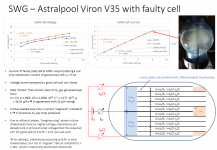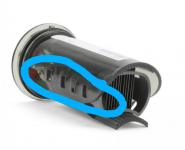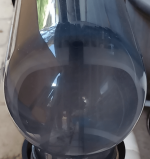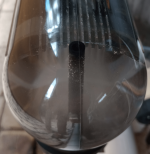OK, there is an update. Fluidra service tech came out yesterday. No spiel about phosphates or water parameters in general, didn't even ask for them. Just poked in a salt meter, seemed happy with the result. Ran a few checks on the controller, like making sure that it's not just one of the cell polarities during the reversals that's not working, but all good.
Then he suggested to replace the cell. After taking out the old cell, he mumbled "never seen that before, that goes straight to quality". Turned out that the "loose" plates in-between the ones that are connected to plus/minus were not inserted far enough. I had noticed that also last week, but not really taken in, kind of thinking to myself that it looks odd, but must be a feature, just looked to deliberate to not be intended.

. No, double


. The loose plates are kind of on a frame that clicks in, and it wasn't pushed in far enough - clicked into a position for a different plate length. Something gone wrong in final assembly.
Anyway, it all started to make sense. Due to the insufficient plate insertion, the outer plates were basically facing directly the center plate, so that in this region (apart from a very inhomogeneous electric field) the potential difference between "neighbouring" plates was five times higher then intended (even though the distance was of course five times higher, but I don't think that the distance is of principal importance in electrolysis, more of an optimisation parameter). And I suspect that this significantly higher voltage is sufficient to overcome the higher overvoltage for O₂ production by electrolysis of water (2H₂O --> O₂ + 4H⁺ + 4e⁻), which is contributing to the total current. (EDIT: This is actually incorrect. Correct explanation much simpler, see post #40. I updated below picture)
In the meantime, I had also measured the voltage supplied to the old cell, not just the current, which turned out to be nonlinear with increasing output-percentage, which didn't look right.
After the cell replacement, I measured current and voltage again. Current was exactly the same, which makes sense, as that's what the controller uses to adjust the Cl₂-output. But the voltage with the new cell was now perfectly linear with increasing output-percentage and about 2V higher compared to the old cell. That means that with the old cell, the controller could create the same current with less voltage, which I take as an indication that there was an additional electrolysis process (presumably oxygen electrolysed from water) creating current. (EDIT: correct explanation, see post #40)
Here an overview with my measurements and my interpretation, hope that makes sense:

Last night, I ran a chlorine gain test with the new cell, and it seems to add up now, but will run another test or two next week or so.
Anyway, happy with my new cell (so far at least - knocking on wood and running a few more chlorine gain tests). And also happy with the Fluidra customer service and the service tech, no complaints there.





